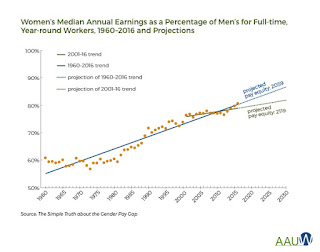The American Association of University Women has a surprisingly good study of the gender wage gap which breaks down the disparity in a number of ways, but I wanted to focus particularly on this graph:
What's most interesting is the aggregate earnings gap (which is what is generally discussed, without diving down into specifics) from 2001-2016. The gap is on a long-term diminishing trend since 1960, but that longer-term regression line is on a steeper slope than more recent decades. That is, change is slowing down. While a lot of this report spins its wheels with the usual intersectional nonsense that adds nothing to the discussion, knowing that we have reached or can project some kind of possible upper limit of what women collectively are liable to do in the labor marketplace is valuable. Women do not sign up for STEM careers generally (engineering and computer science particularly) that pay better than a lot of other degreed careers. They take time off from careers for motherhood, further pressing down on wages. The refusal to deal with these kinds of crucial details hasn't deterred the wage gap vooodooists, who believe absolute numerical gender parity is not only possible but desirable. Never mind that women themselves prefer to marry men with higher incomes than they earn, and demonstrably place a higher value on male earning power than any other single polled trait of either sex. The wage gap may narrow, but it will never vanish — precisely because women reward men for maintaining it.

No comments:
Post a Comment